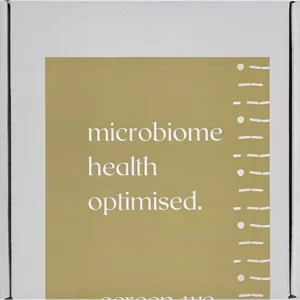We are lucky to have a guest blog post from our friends at FUTURE WOMAN, who specialise in helping women tackle the challenges of hormone imbalances. But which hormonal issues most often impact fertility? Let’s dive into the five most common imbalances they encounter—and how to address them effectively.
1. High androgens and PCOS
Androgens, like testosterone, aren’t just for men! This group of hormones is vitally important to our overall reproductive health as women. And when levels are too high, it can lead to irregular periods and difficulties getting pregnant by preventing ovulation from occurring. The most common disorder of high androgens is polycystic ovarian syndrome (PCOS) which affects 1 in 10 women.
More than Just Testosterone
You might be surprised to know that there are many different androgens to consider, not just testosterone! And like oestrogen, we need to look at how well our androgens are metabolised too. A metabolite of testosterone called 5-DHT is dominant in women with PCOS about 40% of the time – and this metabolite is THREE times more potent than testosterone. Hormone metabolites can only be tested in a urine test (you can’t find this out in a blood test).
Signs of High Androgens
Signs your androgens or androgen metabolites are too high include irregular or missing periods, excess facial hair, head hair loss, acne, weight gain and fertility issues.
Testing Androgens and Androgen Metabolism
It’s important to note that you can’t test hormone metabolism in a blood test, so seeking out a comprehensive urine test for hormones, like our Advanced Hormone Test is key.
2. Low oestrogen
Low oestrogen is a common and often overlooked hormone imbalance as much of the spotlight is often on high oestrogen. When oestrogen is too low, there is a high likelihood that ovulation does not occur – oestrogen needs to reach a certain threshold in order to trigger ovulation. This can lead to missing or irregular periods.
Signs of Low Oestrogen
Like all our hormones, oestrogen plays a bigger role in the body than just reproduction. Symptoms associated with low oestrogen include aches and pains, abdominal weight gain, hot flushes and night sweats, low mood, vaginal dryness and dry skin. If you have a long follicular phase, this could also be a sign of low oestrogen.
Causes of Low Oestrogen
Low oestrogen in premenopausal women is often linked to stress. We see many young women presenting with low oestrogen and missing periods who are experiencing high levels of stress, too much exercise, and/or aren’t eating enough.
Testing Oestrogen Levels
Testing oestrogen alongside other markers like cortisol and nutrient levels is key to understanding what’s driving your low levels.
3. High cortisol and stress
One of the most common hormonal patterns that we see at FUTURE WOMAN is symptoms of hormone imbalances and fertility issues caused by underlying high cortisol.
Cortisol is a hormone produced by our adrenal glands in response to a stressor. This stressor can be perceived stress (family, work, relationships) or physical stress (infections, inflammation, lack of sleep, toxins, too much exercise).
As women, when cortisol is too high, the body will prioritise survival over reproduction. This can lead to irregular or missing periods in younger women, or symptoms of unopposed estrogen due to missed ovulation in more mature women.
High or Low Cortisol Can Cause Fertility Issues
Interestingly, if your cortisol output has been high for too long, you may end up with low cortisol – the body isn’t able to keep up with the demand and so levels drop. This can also negatively impact fertility. Like Goldilocks we want our cortisol to be just right!
Signs of High Cortisol
Signs that your cortisol may be too high include feeling wired, heart palpitations, insomnia or poor sleep, weight gain (especially around the middle), headaches, increased irritability, irregular periods and new symptoms like heavy or painful periods.
Testing Cortisol
For a complete assessment of your cortisol, it’s important to look at not just free cortisol levels (which represents less than 5% of your total output), but also metabolised cortisol levels (how much is produced and cleared during one day). Interestingly, there is a strong correlation between low metabolised cortisol and an underactive thyroid.
4. Thyroid imbalances
The thyroid is a key player in women’s reproductive health and deserves attention. One of its primary functions is regulating the body’s metabolism, which directly influences the menstrual cycle and overall reproductive health. The most common thyroid imbalance we see at FUTURE WOMAN is an underachieve thyroid.
Signs of an underactive thyroid
When the thyroid is underachieve (also known as hypothyroidism), it causes the metabolism to slow down often resulting in weight gain, low energy, cold extremities, depression, constipation, dry skin, heavy periods, or irregular periods.
Causes of Hypothyroidism
The thyroid can be affected by many different factors including poor diet, stress, environmental toxins, gut health, pregnancy, and more.
5. Low progesterone and high oxidative stress
Low progesterone levels is one of the most common causes of fertility issues. Low progesterone together with high oxidative stress often create a vicious cycle that affects fertility and overall health.
Causes of low progesterone
Progesterone, crucial for a healthy luteal phase and pregnancy, can be depleted by chronic stress, poor nutrition, toxins, and hormonal imbalances like HPA axis dysregulation or high androgens.
Simultaneously, oxidative stress—caused by an overload of free radicals due to environmental toxins, poor diet, and chronic inflammation—can impair ovarian function, egg quality and, in turn, progesterone production. The relationship is bidirectional: low progesterone exacerbates oxidative stress, as this hormone has antioxidant properties that protect reproductive tissues. We test both markers at FUTURE WOMAN.
Signs of Low Progesterone
Common signs of low progesterone include anxiety, poor sleep, PMS and a shorter luteal phase of less than 11 days.
Testing Progesterone Levels
If you’re testing progesterone, it’s important to do it at the right time of your cycle. At FUTURE WOMAN we specifically test mid way through the luteal phase to capture this hormone at its peak.
A bit more about FUTURE WOMAN & what they do
FUTURE WOMAN offers personalised health plans, powered by their comprehensive, at-home hormone testing. If you’re struggling with fertility troubles, their Advanced Hormone Test analyses over 30 biomarkers, including oestrogen, progesterone, androgens, hormone metabolism, cortisol, oxidative stress and more. 92% of their clients report feeling better within 6 weeks of following their personalised plan.
Thank you to Future Woman for writing this feature blog post for ScreenMe. We hope this has answered some questions for our community and given a greater insight into how your hormonal health can impact your fertility and reproductive health!




